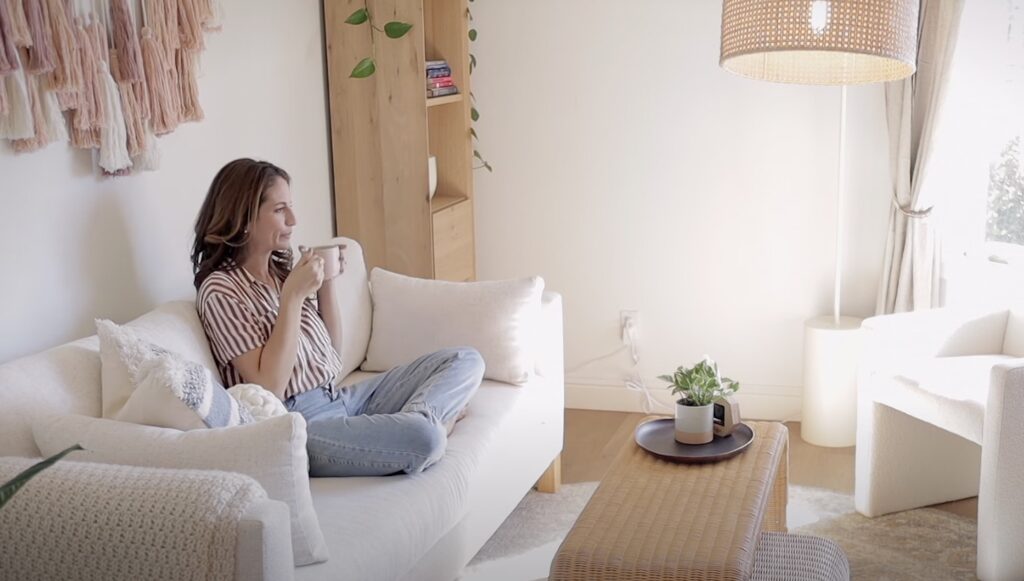Have you ever considered the importance of hospitality as a therapist? How much intention have you given to making your client feel comfortable and cared for?
One area of the therapeutic experience that I’m obsessed with is the idea that hospitality is a critical component of the therapeutic process.
Now, please don’t mishear me. I don’t want to minimize therapeutic training, or the actual strategies that we are implementing with clients!
The point I want to emphasize is that hospitality, as a therapist, is one of the ways we can make our clients feel that we care for them. It’s all the little things we do to help our clients like they are a priority.

Have Grace For Yourself
Before I go through the list, I want to emphasize that if there is anything I name here that you’re missing in how you operate with your clients, be kind to yourself. None of us are at 100 all the time. Offer yourself grace as you invite healthier habits into becoming more hospitable as a therapist.
12 Ways To Show Hospitality As A Therapist
1) Be Mindful Of Your Online Presence
Make your online presence hospitable by letting potential clients know what to expect before you meet.
Tell folks what to expect from sessions. Post pictures of the inside of your office, or of you in your virtual therapy office. If you’re looking for a doctor or a spa or almost anything, don’t you look for pictures? I do!
2) Respond To Messages
Respond to messages promptly.
If you are away or can’t respond quickly, have an away message to let folks know when to expect to hear from you.
3) Keep On Top Of Your Schedule
If you’ve noticed that you’ve double-booked clients on multiple occasions, or you’ve forgotten about sessions more than once, it’s a good time to consult with a trusted colleague about how you can improve your practices so that doesn’t become a pattern.
I had a supervisor once who was in charge of my schedule. A couple of times a month I’d walk into the waiting area to notice two of my clients sitting there for an appointment that they both had a digital confirmation for. It was such a frustration for me and my clients.
4) Get Your Head Right

Get into the right headspace before sessions.
Help get yourself into the therapeutic frame. Clients can tell if you are feeling flustered when you pop into the waiting room or you log onto your virtual session.
Anything you can do to pause, meditate, and slow down before your sessions is going to help your clients feel so much more cared for.
5) Start On Time
Obviously, we all have our moments (including me!) when we start sessions a few minutes late.
But, if you are consistently showing up late for most of your sessions, then that is going to wear on the therapeutic relationship.
If this is an issue you are struggling with, then it’s a good time to get some consult support and try to address that.
6) Clean Your Space
This feels fairly obvious, but a number of my past therapists had extremely messy offices. Like, books stacked all over their desk and on the floor messy.
This applies whether you are meeting in-person or virtually.
Meeting in a messy space can affect your client. They may feel overwhelmed and are less likely to have a positive experience in your space.
Even if all you are doing is shoving items that are piling up in a cupboard or a drawer, it helps to have an organized space.
7) Hold Confidentiality Sacred
Consider confidentiality to the nth degree!
Anything you can do to make your space as private as possible, do it.
Adding $10 of weather stripping (affiliate link) to your windows and doors and a door sweep will make a massive difference.
And if you’re working from home with littles around, add any extra barriers you can to minimize sounds and intrusions.
Also consider any windows. Can people see in?
8) Consider Your Population’s Needs
Make your space accessible and comfortable for your population.
Does your space need to be wheelchair accessible? Do you have gender affirming restrooms? Do you have toys in the waiting room if you work with kids? Is your office accessible via public transportation?
Consider your population’s preferences and make your space -whether in person or virtual – serve their needs well.
9) Make Technology Smooth

Make all technological interactions as smooth as possible.
For virtual sessions, is it easy to access your secure platform? Is it confusing?
I heard from someone once that they were supposed to receive a unique link for each of their scheduled virtual sessions, but come their session time, they hadn’t received it. They would play phone tag with their therapist for the first several minutes every time just trying to figure out how to log in.
Consider every technological touch point you have with clients: charging their card, coordinating scheduling, and anywhere else you leverage hipaa-secure technology in your practice. Try to make it as streamlined as possible.
10) Don’t Use Your Phone
Hopefully, this goes without saying. Do not accept phone calls or check your phone during sessions.
I wish I didn’t even have to include this, but I know that it happens.
For virtual therapy, don’t interact with other items on your screen unrelated to your work with your client.
If there is an unusual circumstance, make sure that you let your client know about this in advance.
11) Keep Your Office Safe
Make sure your in-person waiting room feels safe.
For meeting in-person, I’ve found over the years that it’s essential to have either a door that locks between your office and the outside world, or a receptionist.
Before I learned this lesson, I would be in-session only to discover that someone was yelling in the hallways. I would then have to lock myself and my client in my office and hope that the intruder would leave.
I’ve also discovered that someone had smoked substances in the suite when no one was around. Imagine how alarmed my clients were when these things happened.
12) Add A Personal Touch
Think of a few little details that are uniquely “you” to incorporate in your therapy work.
For me, I like to pop my head into the waiting room a couple of minutes before a session begins to offer a cup of coffee or water.
I also have a few items in my office that I made by hand. My clients might not know this, but I like to think the love comes through.
Why Is Hospitality As A Therapist Important?
All of these things, though they seem to have very little to do with the “actual therapy,” all help communicate to your clients that you care about them. You want them to know that during the time you have together, they are your absolute priority.
You can imagine, if a therapist was always late to session, didn’t return your messages, responded to calls in the middle of session, and their space was a mess with questionable confidentiality, it would be really hard to believe that they were prioritizing your care.
And we know that feeling as though your therapist genuinely cares about you is the most consistent variable predicting positive outcomes in treatment.
If you feel like you are challenged by any of these ways to have hospitality as a therapist, please don’t be hard on yourself. None of us are getting it perfect all the time! It’s more helpful to identify the issue and try to make changes to improve it. And yes, this is a great item to bring up in a consult group.
Extra Tips
Want to make sure you are making your clients feel welcome right from the start? Check out my article on 7 important steps to take when you meet with a client for the very first time.
And, of course, a hospitable therapy office is so important in creating a comfortable environment for your clients. Here are 5 essential therapy office furniture recommendations for putting together a warm and homey space.
And until next time, from one therapist to another: I wish you well!
-Marie
Photo by MART PRODUCTION from Pixels
Leave A Reply